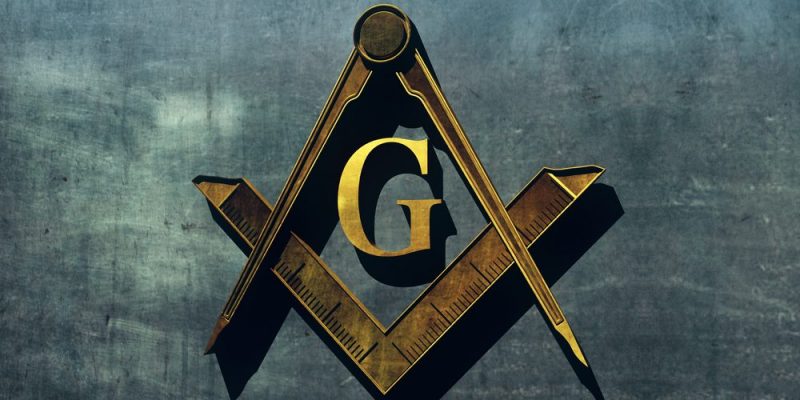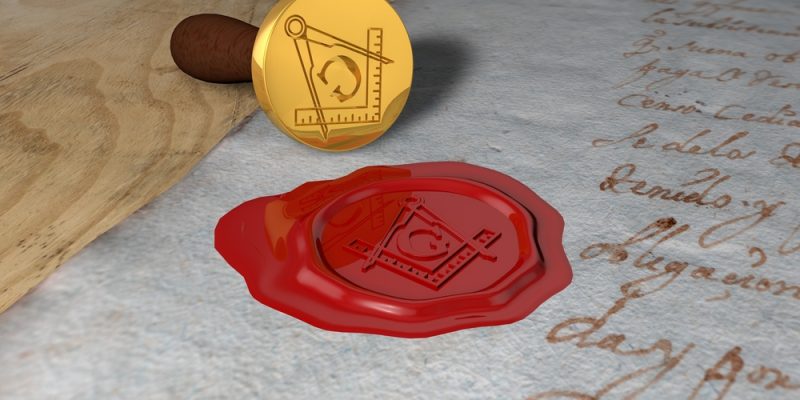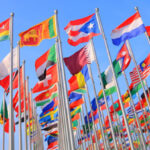We explain what Freemasons are and in what degrees they are organized. Also, the symbols they use and the conspiracy theories around Freemasonry.

What are masons?
The Freemasons are the members of Freemasonry or Freemasonry, an international society of a discreet nature (originally a secret society), which defends humanist, philosophical and philanthropic ideas. Freemasonry is organized in lodges and in a hierarchical structure based on degrees. It is founded around a feeling of brotherhood among its members that aspires to brotherhood among all human beings.
It functions as an initiatory institution, that is, it admits as members and reveals its secrets only to those who pass certain initiation rites. Promotes the search for truth through the philosophical study of human being the cultivation of sciences and arts, and the contribution to social progress and the moral and spiritual development of the individual.
Freemasons are identified by a series of symbols linked to masonry or Royal Art (as the construction of large buildings, such as cathedrals, was called in the Middle Ages). Its main symbols are the compass and the square as well as the acronym GADU, which means “Great Architect of the Universe”, an important Masonic concept that symbolizes the supreme power that gives meaning to existence, either as a transcendental force or as an aspiration of human knowledge.
Freemasonry arose in Europe at the end of the 17th century and beginning of the 18th century as a symbolic, philosophical and speculative derivation of the guilds of medieval stonemasons and builders. The first Grand Lodge, which brought together four pre-existing lodges, was born in England in 1717.
Some origin myths attribute the founding of Freemasonry to an allegorical character called Hiram Abif, supposed architect of the Temple of Solomon in Jerusalem, or to historical figures such as the builders of the pyramids of Ancient Egypt, the Collegia Fabrorum Romans (associations of artisans and builders of Ancient Rome) or various orders of Christian knights of the Middle Ages (such as the Templars).
Masonic lodges acquired organizational aspects taken from both builders' guilds and some religious orders and brotherhoods of knights. Both the lodges and their members were involved in important historical events like the independence of the Spanish American nations. For example, Simón Bolívar, José de San Martín and Manuel Belgrano were Freemasons.
Today, Freemasonry is maintained as a set of lodges that promote the values of tolerance, tradition, liberal sciences and arts, and spiritual search. Therefore, it is considered an initiatory society outside of states and churches.
The term “mason” comes from French maçonwhich means “bricklayer” and “freemason” from French francmaçonwhich refers to a mason specialized in carving loamstone (easy-to-carve stone, such as sandstone or limestone).
Key points
- Freemasonry is an initiatory and discreet society that is organized into lodges and hierarchical degrees. Promotes fraternity, moral and spiritual development and philosophical study.
- It emerged in Europe at the end of the 17th century and the beginning of the 18th century. It is currently divided into two main branches: regular or Anglo-Saxon Freemasonry and liberal or continental Freemasonry.
- Freemasons have a series of symbols that identify them, such as the compass and square, the eye of providence, the chain of union, the two columns of the Temple of Solomon and the checkered floor.
- The discreet and sometimes secret nature of Masonic meetings led to the creation of conspiracy theories, such as belief in a Masonic plan for world domination, and links to the Illuminati and Satanism.
See also: Humanism
Branches of Freemasonry

Freemasonry is divided into two main currents:
- Regular or Anglo-Saxon Freemasonry. Headed by the United Grand Lodge of England, which emerged at the beginning of the 19th century from the First Grand Lodge of England that was founded in 1717, it has its largest area of influence in the United Kingdom, the countries of the British Commonwealth, the United States and part of the United Kingdom. of continental Europe. It also has representation in Latin America. Its main features are:
- It holds the belief in the Great Architect of the Universe, a God or transcendent principle considered the creator of the universe.
- Their oaths are sworn on a religious text, called the Volume of the Sacred Law, which is usually the Bible (although this can vary).
- It does not accept women among its members nor does it allow female initiation.
- It prohibits discussions of politics and religion, and the institution takes no official stance on such matters.
- Liberal or continental Freemasonry. Known as the adogmatic current, called “irregular” or “not recognized” by the United Grand Lodge of England, it follows in the footsteps of the Grand Orient of France, an association of Masonic lodges that emerged at the end of the 18th century. It is mainstream in France, French-speaking Africa and some continental European countries. It also has a presence in Latin America. It is a more progressive branch than regular Freemasonry. Its main features are:
- It defends absolute freedom of conscience, which is why it admits believers as well as agnostics and atheists.
- It accepts the initiation of both men and women, whether in separate or mixed lodges.
- He does not use the Volume of the Sacred Law in his rites, but a Masonic Constitution.
- It encourages the debate of ideas in complete freedom, including religious and political topics, and promotes secularism and republicanism.
How are the Freemasons organized?
The masons are organized in lodges that, in turn, are usually grouped into obediences like those that bear the name of Grand Lodge or Grand Orient. These lodges call meetings called meetings and hold rituals or ceremonies that are exclusive to members.
In the main currents of Freemasonry There are three degrees, which represent three stages of the initiate's personal development. These are:
- Apprentice. It is the degree of the newly initiated, who are introduced to the knowledge of the symbols of Freemasonry and their meaning, and whose task is to confront themselves and control their passions.
- Buddy. It is the intermediate degree, in which Freemasons acquire greater knowledge of the philosophy of Freemasonry and its relationships with the outside world.
- Teacher. It is the degree of those who have achieved advanced knowledge and must learn the duties and virtues that correspond to that rank, participate in all the rites of the lodge and access spiritual and arcane knowledge.
However, In many lodges there are degrees that are added or superimposed on the three main ones. The best known case is that of the Ancient and Accepted Scottish Rite, practiced by many lodges in various parts of the world. This rite recognizes 33 degrees: the first three (apprentice, companion and master) depend on the respective Grand Lodges, and the next thirty degrees are under the jurisdiction of the Supreme Council of the 33rd Degree of each country or region. In this case, the 33rd degree is the highest level in the hierarchy of Masonic education. On the other hand, The highest authority of a Grand Lodge is known as the grand master.
Masonic symbols
Freemasonry is identified with a series of symbols:
- The compass and the square. They are represented together and are the symbol that identifies Freemasonry. Of uncertain origin, but linked to masonry and architecture (activities of mathematical precision), the square represents righteousness and virtue, and the compass the limits and duty that every Mason maintains with respect to others. These symbols are usually accompanied by the letter G, which is believed to represent Geometry or guidance from the Great Architect of the Universe.
- The all-seeing eye. It is often called the “eye of providence” and is associated with perfection, stability and harmony (represented by the equilateral triangle) and with wisdom, illumination and divine surveillance and guidance (represented by the eye and rays).
- The chain of union. In Masonic meetings, initiates usually form a chain by holding hands, which symbolizes the union and fraternity between the members, who present themselves as links of the same chain. In some cases, chains are represented in architectural contexts with the same meaning.
- The checkerboard or checkered floor. The mosaic pavement made up of black and white squares found in some areas of Masonic temples and monuments symbolizes the complementarity of opposites, such as good and evil or light and darkness, and also tolerance.
- The two columns. Masonic temples include as part of their architectural design two columns that represent the pillars that, according to the Bible (1 Kings 7:21), stood in front of the portico of Solomon's Temple, called Jachin (right) and Boaz (left). Both columns symbolize strength and stability.
Conspiracy theories and myths about the Freemasons

The discreet nature of Freemasonry, and the secrecy surrounding some of its practices, made it the subject of numerous myths and conspiracy theories.
Some have to do with an alleged Masonic plan for world domination, such as the Judeo-Masonic conspiracy that various anti-Semitic groups or governments denounced at the beginning of the 20th century or the belief in the influence of Freemasonry in an alleged hidden plan of global government, called the New World Order which gained some popularity after the end of the Cold War.
Other conspiracy theories, which sometimes overlap with those mentioned above, stand out an alleged connection between Freemasonry and the Illuminati an 18th century secret society that promoted the ideas of the Enlightenment. Some beliefs suggest that the Illuminati never ceased to exist and that they were protagonists of important events in recent history. Furthermore, they claim that some Masonic personalities and symbols actually belong to the Illuminati. However, the Illuminati had no relationship with Freemasonry and was dissolved at the end of the 18th century.
The Catholic Church and Islamic authorities repeatedly condemned membership in Freemasonry. The main reason was probably the fact that Freemasons usually defend secularism, and that Masonic rituals are considered incompatible with the doctrines of Catholicism and Islam. However, arguments against Freemasonry sometimes turned to alleged ritual practices believed to be linked to the occult, the supernatural, alchemy or even Satanism.
See also:
References
- Bogdan, H. & Snoek, JAM (Eds.). (2014). Handbook of Freemasonry. Brill.
- Master Mason (sf). The Mason's Blog. https://elblogdelmason.com/
- Grand Lodge of Argentina of Free and Accepted Masons. (sf). What is Freemasonry? https://www.masoneria-argentina.org.ar/
- Önnerfors, A. (2017). Freemasonry: A Very Short Introduction. Oxford University Press.
- The Editors of Encyclopaedia Britannica. (2024). Freemasonry. Encyclopedia Britannica. https://www.britannica.com/





